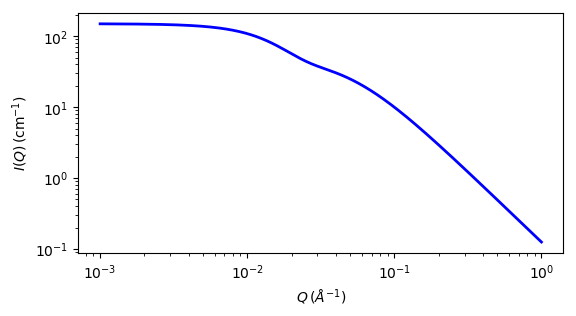gauss_lorentz_gel¶
Gauss Lorentz Gel model of scattering from a gel structure
Parameter |
Description |
Units |
Default value |
|---|---|---|---|
scale |
Scale factor or Volume fraction |
None |
1 |
background |
Source background |
cm-1 |
0.001 |
gauss_scale |
Gauss scale factor |
None |
100 |
cor_length_static |
Static correlation length |
Å |
100 |
lorentz_scale |
Lorentzian scale factor |
None |
50 |
cor_length_dynamic |
Dynamic correlation length |
Å |
20 |
The returned value is scaled to units of cm-1 sr-1, absolute scale.
This model calculates the scattering from a gel structure, but typically a physical rather than chemical network. It is modeled as a sum of a low-q exponential decay (which happens to give a functional form similar to Guinier scattering, so interpret with care) plus a Lorentzian at higher-q values. See also the gel_fit model.
Definition
The scattering intensity I(q) is calculated as (Eqn. 5 from the reference)
Ξ is the length scale of the static correlations in the gel, which can be attributed to the “frozen-in” crosslinks. ξ is the dynamic correlation length, which can be attributed to the fluctuating polymer chains between crosslinks. IG(0) and IL(0) are the scaling factors for each of these structures. Think carefully about how these map to your particular system!
Note
The peaked structure at higher q values (Figure 2 from the reference) is not reproduced by the model. Peaks can be introduced into the model by summing this model with the gaussian_peak model.
For 2D data the scattering intensity is calculated in the same way as 1D, where the q vector is defined as

Fig. 104 1D plot corresponding to the default parameters of the model.¶
Source
References
G Evmenenko, E Theunissen, K Mortensen, H Reynaers, Polymer, 42 (2001) 2907-2913
Authorship and Verification
Author:
Last Modified by:
Last Reviewed by: